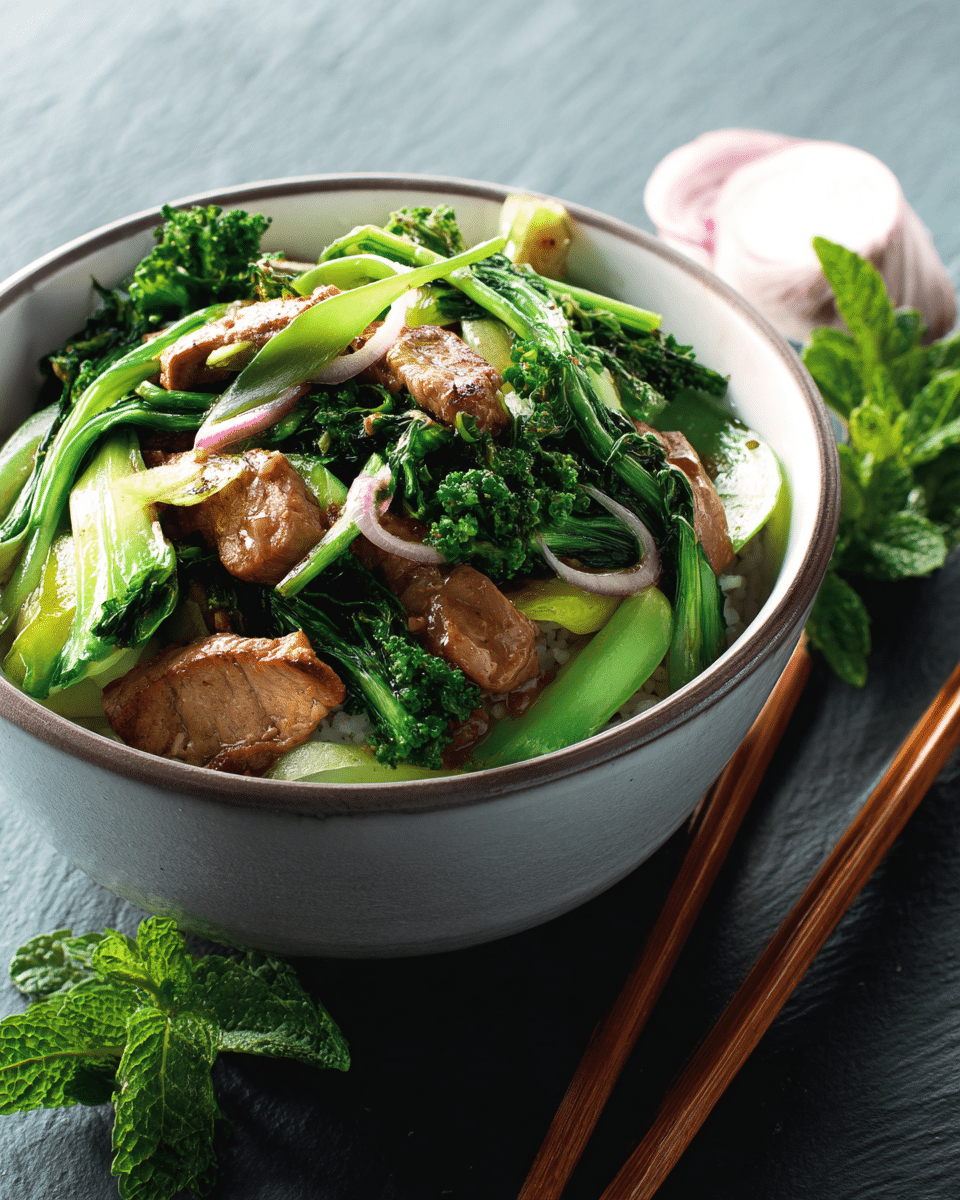The balance of tender pork, crunchy Asian greens, and a bold garlic soy glaze makes this dish an instant favorite for anyone craving fast and delicious Asian-inspired fare. The flavors come together in perfect harmony, with the subtle sweetness of hoisin and the umami of oyster sauce dancing over crisp vegetables.
Whether you’re aiming to eat clean, whip up a quick midweek dinner, or impress with a colorful stir-fry, this meal has you covered. Plus, it’s adaptable—swap the pork for tofu or chicken, and adjust the spice to your liking. Every bite is a flavor bomb waiting to be devoured.
Full Recipe:
-
500g pork loin or tenderloin, thinly sliced
-
2 tablespoons vegetable oil
-
2 garlic cloves, minced
-
1 tablespoon fresh ginger, grated
-
1 red chili, finely sliced (optional)
-
1 bunch baby bok choy, chopped
-
1 bunch broccolini, trimmed and halved
-
100g snow peas, trimmed
-
2 tablespoons oyster sauce
-
1 tablespoon soy sauce
-
1 tablespoon hoisin sauce
-
1 teaspoon sesame oil
-
1 tablespoon water
-
1 teaspoon cornstarch (optional, for thickening)
-
Cooked jasmine rice, to serve
-
Sesame seeds and sliced green onions, for garnish
Directions:
-
In a small bowl, whisk together oyster sauce, soy sauce, hoisin sauce, sesame oil, water, and cornstarch (if using). Set aside.
-
Heat 1 tablespoon oil in a wok or large frying pan over high heat. Add the pork slices and stir-fry for 3–4 minutes or until golden and just cooked through. Remove from the wok and set aside.
-
Add the remaining oil to the wok. Sauté garlic, ginger, and chili for 30 seconds until fragrant.
-
Toss in the bok choy, broccolini, and snow peas. Stir-fry for 2–3 minutes until just tender but still crisp.
-
Return the pork to the wok. Pour over the sauce and toss everything together until well coated and heated through.
-
Serve over jasmine rice, garnished with sesame seeds and green onions.
Prep Time: 10 minutes | Cooking Time: 10 minutes | Total Time: 20 minutes
Kcal: 350 kcal | Servings: 4 servings
Recipe Overview
When it comes to quick, healthy, and satisfying meals, few dishes hit the mark quite like a Pork & Asian Greens Stir-Fry. It’s that kind of recipe you turn to after a long day—something that doesn’t take much time, doesn’t require fancy ingredients, and still tastes like it came from your favorite local takeaway. This dish brings together tender slices of pork, crisp seasonal greens, and a savory garlic-soy glaze that clings to every bite. It’s light yet comforting, nourishing but deeply flavorful.
Ideal for weeknight dinners or when you’re craving something bold and vibrant, this stir-fry is a celebration of balance—between textures, flavors, and nutrition. Whether served over steamed jasmine rice, tossed with noodles, or enjoyed on its own, it’s a dish that leaves you full and happy without any of the fuss.
History and Origin
Stir-frying as a cooking technique dates back over 1,500 years in China, where it emerged during the Han dynasty. The method evolved as a practical solution for quick cooking with minimal fuel—ingredients were cut small, the heat was high, and the entire dish could be ready in minutes. Today, it’s a hallmark of Chinese cuisine and has been adopted and adapted by many Asian cultures.
The inclusion of pork in stir-fries is especially common across China, Southeast Asia, and parts of Korea and Japan. Pork is the most consumed meat in China and is often paired with vegetables that are seasonally abundant—like bok choy, snow peas, or Chinese broccoli.
The modern Pork & Asian Greens Stir-Fry you might find in an Australian or Western home kitchen is a reflection of these traditional roots, but with local adaptations. It’s a perfect example of how global flavors can harmonize in a home-cooked meal. Australian cooks, for instance, often incorporate vegetables like broccolini or even baby spinach, and they simplify the sauce to accommodate pantry staples like oyster sauce, soy, and sesame oil.
Variations and Adaptations
One of the best things about a stir-fry is its incredible versatility. While pork loin or tenderloin is typically used for this recipe due to its lean and tender qualities, it’s easy to swap in chicken, beef strips, tofu, or even prawns based on dietary preferences or what’s available in your fridge.
Vegetables, too, are wonderfully interchangeable. If you can’t find bok choy, pak choy or even regular cabbage works beautifully. Snow peas can be swapped for green beans, bell peppers, or zucchini. If you’re in the mood for something spicier, try adding Thai basil and a hit of chili paste.
Across Southeast Asia, variations of this dish might feature fish sauce, lemongrass, or galangal for a more Thai-inspired profile. In Japan, you might see miso paste added to the sauce for a rich umami note. In Korea, gochujang (a spicy fermented chili paste) could lend both heat and depth. It’s an endlessly adaptable dish that’s just as comfortable dressed up with bold regional flavors as it is kept simple.
Nutritional Information
While exact nutritional values will vary depending on the ingredients and portion sizes, a standard serving of Pork & Asian Greens Stir-Fry is generally balanced and health-conscious.
For a meal featuring 150g of lean pork, a generous cup of mixed greens, and served with half a cup of steamed jasmine rice, you’re looking at roughly:
-
Calories: 350–400 kcal
-
Protein: 28–32g
-
Fat: 12–15g (mostly from healthy oils like sesame and olive)
-
Carbohydrates: 25–35g (mainly from rice and hoisin sauce)
-
Fiber: 3–5g
-
Sodium: Moderate to high depending on soy sauce quantity (you can use low-sodium versions)
Micronutrients include vitamin K, vitamin C, folate, and potassium from the greens, and iron and B-vitamins from the pork. By avoiding deep-frying and using minimal oil, this stir-fry manages to stay light without sacrificing flavor.
Serving Suggestions and Pairings
This stir-fry is typically served hot and fresh, right out of the wok, atop a bed of steamed jasmine or brown rice. However, don’t be afraid to get creative. It also pairs beautifully with soba noodles, vermicelli, or even cauliflower rice for a lower-carb option.
For an even more satisfying dinner, consider serving it alongside a side of steamed dumplings or a simple miso soup. A crisp Asian slaw or cucumber salad would offer a refreshing contrast to the warm, savory stir-fry.
As for drinks, a light lager or a crisp sauvignon blanc pairs excellently with the soy-based flavors. For a non-alcoholic option, try a chilled jasmine green tea or a sparkling yuzu soda for a citrusy zing.
Tips and Tricks for Success
-
Slice it Thin: Thinly slicing the pork against the grain ensures tenderness. If the meat is slightly frozen, it’s even easier to get uniform slices.
-
High Heat is Key: Stir-frying works best when your wok or pan is very hot. This sears the ingredients quickly and locks in flavor without overcooking.
-
Prep Everything First: Since stir-frying happens fast, have all your ingredients chopped and sauces mixed before turning on the heat.
-
Don’t Overcrowd the Pan: Cooking the pork in batches prevents it from steaming and ensures a golden-brown sear.
-
Balance Your Sauce: Taste and adjust your sauce—some like it sweeter (more hoisin), others want more umami (add a dash of fish sauce or miso).
-
Finish with Freshness: A sprinkle of sesame seeds or chopped green onions right before serving adds texture and a burst of flavor.
Potential Health Benefits
Thanks to its use of lean meat and fresh vegetables, this stir-fry is not just delicious—it can be a boon for your health.
Advertisement
-
Pork, especially lean cuts, is rich in protein, B-vitamins (notably B6 and B12), zinc, and selenium. These nutrients support immune health, energy metabolism, and muscle maintenance.
-
Asian greens like bok choy and broccolini are excellent sources of fiber, antioxidants, and bone-strengthening nutrients like calcium and vitamin K.
-
Ginger and garlic, two staple aromatics in this dish, are well-known for their anti-inflammatory and digestive benefits.
-
Using sesame oil in moderation can contribute healthy fats, which are essential for brain and heart health.
As always, balance is key—pairing this dish with plenty of vegetables and moderate rice portions makes it a fantastic option for most dietary goals.
Conclusion
Pork & Asian Greens Stir-Fry is a dish that embodies what great home cooking should be—quick, flavorful, nourishing, and endlessly customizable. Whether you’re trying to eat healthier, reduce your reliance on takeout, or simply cook more meals from scratch, this stir-fry is an easy entry point.
It’s a recipe that respects its Asian culinary roots while inviting you to make it your own. With just a few pantry ingredients and a hot pan, you can create a dish that’s comforting, colorful, and downright crave-worthy. So grab your wok, prep your greens, and give this one a go—you might just find it becoming a weeknight staple in your kitchen.






